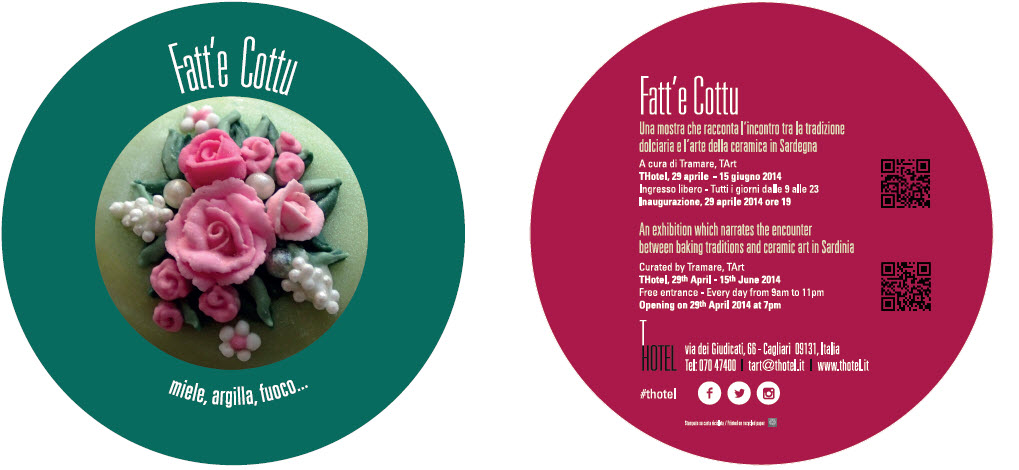FATT’E COTTU – T HOTEL – CAGLIARI – 29 APRILE – 15 GIUGNO 2014FATT’E COTTU – T HOTEL – CAGLIARI – APRIL 29 TO JUNE 15,2014
 THotel, 29 aprile – 15 giugno 2014
THotel, 29 aprile – 15 giugno 2014
A cura di Tramare, TArt
Allestimento a cura di Francesca Picciau per Studio Aranxiu, Tramare
Progetto grafico: Valeria Pesce
“La cultura del dolce in Sardegna costituisce un universo affascinante e denso di significati. I vari tipi di dolci appartenenti al repertorio della tradizione regionale non sono solo buoni da mangiare, ma anche belli da vedere e interessanti da pensare. Nella Sardegna del passato, orizzonte antropologico dai beni limitati, il dolce rappresentava il cibo che distingueva il tempo ordinario da quello della festa; il tempo della penuria alimentare da quello dell’abbondanza ritualizzata. Veri e propri marcatori del tempo, così, i dolci scandivano i momenti salienti del ciclo della vita e del ciclo dell’anno. I dolci votivi dedicati a santi come sant’Antonio Abate, san Giovanni Battista, recano al fondo interessanti tratti di un sincretismo religioso che riconnette la più recente veste cristiana a un originario nucleo precristiano di matrice agraria. La linea di demarcazione fra il pane e il dolce spesso è assai labile, sancita talora solo dalla presenza del dolcificante. Con i pani cerimoniali i dolci condividono la cura per la forma dell’espressione, veicolo di significati simbolici. Vere e proprie opere di “arte plastica effimera”, plasmate da mani esperte il cui sapere è incorporato nel gesto, alcuni dolci realizzano una forma di appagamento pluri-sensoriale. Nel contesto tradizionale il dolce costituiva una sorta di “fatto sociale totale” in grado non solo di dare ordine al fluire del tempo, ma anche di rinsaldare i rapporti di reciprocità, attraverso l’istituto del dono.” THotel , April 29 – June 15, 2014
THotel , April 29 – June 15, 2014
By plotting , Tart
Interiors by Francesca Picciau Studio Aranxiu , plotting
Graphic design: Valeria Fish
“The culture of Sardinia is a sweet and charming universe full of meaning . The various types of sweets belonging to the repertoire of the regional tradition are not only good to eat, but also beautiful to look at and interesting to think about. Sardinia in the past, anthropological horizon from limited goods , the cake was the food that distinguished the ordinary time from that of the party ; the time of food shortages by the abundance ritualized . Real time markers , as well , the sweet chanting the highlights of the life cycle and the cycle of the year. The sweet votive dedicated to saints like St. Anthony Abbot, St. John the Baptist , go to the bottom of interesting traits of a religious syncretism that reconnects the most recent as a Christian to the original nucleus of the pre-Christian agricultural matrix . The line of demarcation between the bread and sweet is often very narrow , sometimes only sanctioned by the presence of a sweetener. With the ceremonial sweet breads share the care for the form of expression , a vehicle for symbolic meanings . Real works of “art plastic ephemeral ,” shaped by expert hands which know is embedded in the gesture , some sweet achieve a form of multi- sensory satisfaction . In the context of the traditional sweet constituted a kind of ” total social fact ” not only able to give order to the flow of time , but also to strengthen relations of reciprocity, through the institution of the gift. “
Leave a Comment
You must be logged in to post a comment.



